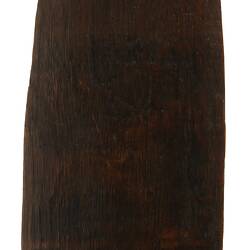Summary
This maker of this shield and their Country, like many items collected in early colonial times, was not properly recorded. Collectors from all walks of life within this era were ignorant of the complex structure of Aboriginal Nations and the vast differences in language, customs and culture. Racist theories, such as the incorrect and highly damaging idea that Aboriginal people were a dying race, led to a frenzy of collecting, with little care for or understanding of the specificity of the cultural item.
Today, museums and galleries which house huge collections of unprovenanced items are slowly attempting to research and work with First Peoples communities to shed light on these cultural items so that they may be properly understood, especially in regard to their Nation of origin and the specific Aboriginal language group or region they belong to.
Physical Description
Wooden shield elliptic in shape. Triangular in cross-section, outer surface slightly convex. One tip of shield is blunted. Carved from one piece of dense wood with handle cut into the solid. Darker band around centre of shield suggests a protective hand covering may once have been attached. Crack extending from one side of handle.
Significance
When this shield was made, young boys from infancy were taught to use weapons for hunting and in defence, their skill and accuracy improving with their growth and increasing strength. Children played with their own diminutive weapons around camp and when collecting food with the adults. By the time each boy reached manhood, he was well accustomed to using his weapons and tools.
Boys engaged in many hunting and fighting games from a very young age, so were accustomed to throwing the spear and in the habit of defending themselves from it. They began by throwing reeds at each other, and were soon expert at dodging these 'spears' both through quick movements of their body and by using a toy shield for defence. These mock fights were staged regularly by young boys and by practising with toy shields they learnt the skills necessary to defend themselves as adults engaged in real battle.
The toddlers who were too young to use a real spear practised with grass stems and held a bunch of grass or small piece of bark as an imitation shield.
More Information
-
Object/Medium
Shield
-
Maker
-
Locality
-
Collector
-
Date Collected
-
Object Measurements
640 mm (Length), 80 mm (Width), 70 mm (Height)
-
Classification
-
Date Made
-
Maker
-
Clan/Language Group
-
Place Made
-
Indigenous Region
-
Keywords
-
Collection Names
-
Type of item
-
Discipline
-
Category
-
Collecting Areas



